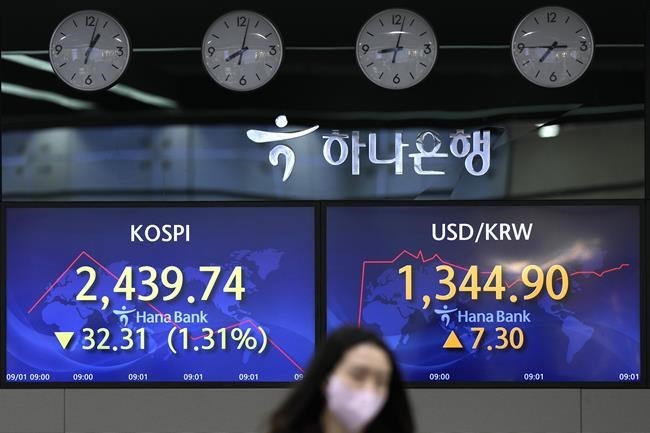
A currency trader walks by the screens showing the Korea Composite Stock Price Index, left, and the foreign exchange rate between U.S. dollar and South Korean won at a foreign exchange dealing room in Seoul, South Korea, Thursday, Sept. 1, 2022. THE CANADIAN PRESS/AP-Lee Jin-man
Republished September 02, 2022 - 2:09 PM
Original Publication Date September 02, 2022 - 8:41 AM
Canada's main stock index snapped a five-day losing streak Friday, led by gains in the energy and mining sectors.
The S&P/TSX composite index closed up 128.13 points at 19,270.85, bringing an end to the sell-off that began last week when Federal Reserve Chair Jerome Powell gave a speech indicating the U.S. central bank will likely need to keep interest rates high for some time in order to bring inflation down.
The speech, which Powell gave at an annual economic symposium in Jackson Hole, Wyo., immediately sent North American stock markets into a tailspin.
All year, investors have been worried that overly aggressive central bankers could raise interest rates to high and tilt the economy into a full-fledged recession. That fear seemed to relax somewhat this summer, leading to a six-week stock market rally in late July and early August, but Powell’s speech immediately turned investor sentiment negative again.
In Canada, the S&P/TSX composite was weighted down even more by the declining price of crude oil this week and the negative impact that had on the index’s energy stocks. On Friday, however, crude oil rallied, lifting oil and gas stocks with it, and boosting the TSX.
The October crude contract was up 26 cents at US$86.87 per barrel on Friday.
"On the oil front, OPEC meets next week and there is some thought that they will reduce output. By reducing output, they will reduce supply," said Anish Chopra, managing director with Portfolio Management Corp.
"And so the energy stocks are responding to that potential today.”
Natural gas prices also moved higher Friday on news that Russian energy giant Gazprom won't resume the supply of natural gas through a key pipeline to Germany for now, citing what it said was a need for urgent maintenance work to repair key components, just hours before it was due to restart deliveries.
The Russian state-run energy company had shut down the Nord Stream 1 pipeline on Wednesday for what it said would be three days of maintenance.
But while the TSX enjoyed a healthy rally Friday, stocks on Wall Street traded lower. In New York, the Dow Jones industrial average was down 337.98 points at 31,318.44. The S&P 500 index was down 42.59 points at 3,924.26, while the Nasdaq composite was down 154.27 points at 11,630.86.
The U.S. indexes had initially posted gains Friday morning, after the release of new jobs data that showed U.S. employers slowed their hiring in August. That put traders in a buying mood, stoking cautious optimism that the overheated economy may be cooling and the Federal Reserve may not need to raise interest rates as aggressively as planned.
However, stocks turned lower in afternoon trading as investors appeared to change their minds about the significance of the more subdued jobs report.
"When you take a step back as an investor, the Federal Reserve is still trying to get inflation below its two per cent target. And it’s much higher than that, so interest rates are still going to continue to increase,” Chopra said.
"The probability of a 75-basis point hike fell today, but it’s the path of interest rates that really matters – rates are still going up and are going to stay higher for longer.”
The U.S. Federal Reserve is set to make a decision on interest rates when it next meets Sept. 20-21.
The Bank of Canada will make its own interest rate announcement next Wednesday. Some of Canada’s major banks are forecasting the central bank will raise its key interest rate by three-quarters of a percentage point on Wednesday.
The Bank of Canada hiked its key rate in July by a full percentage point – the largest single rate increase since August 1998 after a series of hikes that began in March. Previously, the rate had been at 0.25 per cent where it sat since it was slashed to near-zero early in the pandemic.
The Canadian dollar traded for 76.21 cents US compared with 75.95 cents US on Thursday.
The December gold contract was up US$13.30 at US$1,722.60 an ounce and the December copper contract was up one cent at US$3.41 a pound.
This report by The Canadian Press was first published Sept. 2, 2022.
— With files from The Associated Press and Nojoud Al-Mallees, The Canadian Press
Companies in this story: (TSX:GSPTSE, TSX:CADUSD=X)
News from © The Canadian Press, 2022